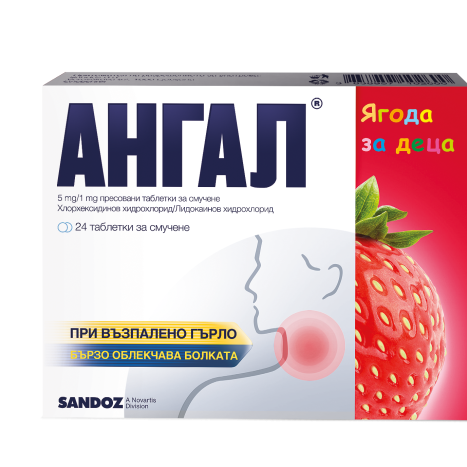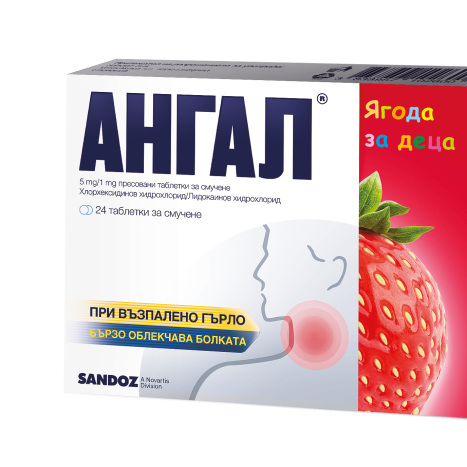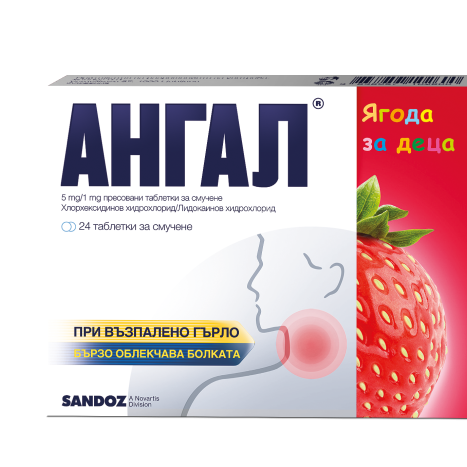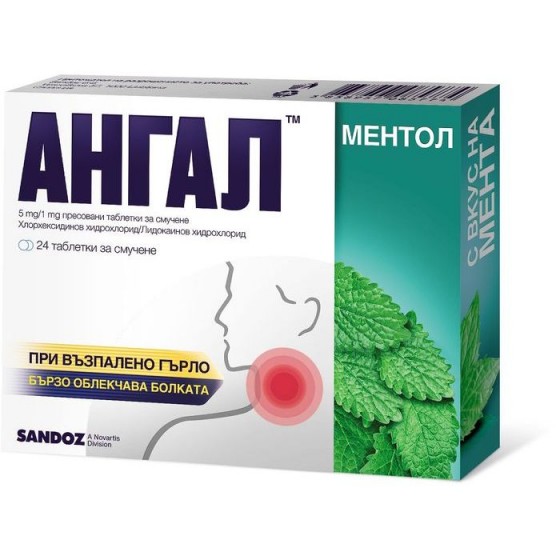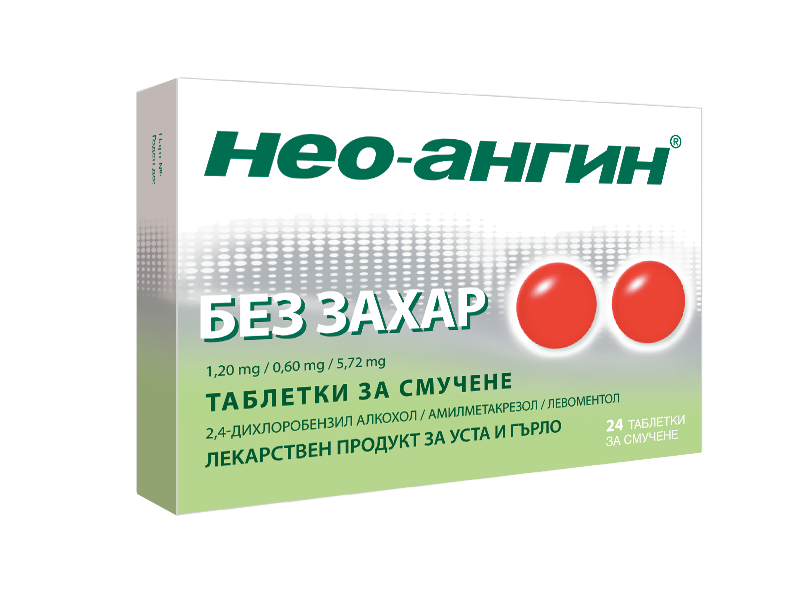ANGAL STRAWBERRY for kids 5mg/1mg for sore throat with strawberry for kids x 24 tabl
BRIEF DESCRIPTION OF THE PRODUCT
- NAME OF THE MEDICINAL PRODUCT
Angal Strawberry for children 5 mg/1 mg compressed lozenges
Angal Strawberry for Kids 5 mg/1 mg compressed lozenges
2. QUALITATIVE AND QUANTITATIVE COMPOSITION
1 lozenge contains 5 mg of chlorhexidine hydrochloride and 1 mg of lidocaine hydrochloride .
Excipients with known effect: sorbitol.
For the full list of excipients, see section 6.1
3. PHARMACEUTICAL FORM
Compressed lozenge.
Angal Strawberry for children is a white to off-white, slightly speckled lozenge with a round shape and a strawberry flavor.
4. CLINICAL DATA
4.1 Therapeutic indications
Angal Yagoda for children is indicated for symptomatic and local treatment of diseases of the pharynx. It acts as a disinfectant and local anesthetic for sore throats and conditions of the pharynx and oral cavity accompanied by irritation and painful swallowing, such as pharyngitis, gingivitis, stomatitis and aphthae. The presence of lidocaine in the composition leads to rapid relief of symptoms.
In cases of bacterial infection accompanied by high fever, additional treatment is required.
Angal Strawberry for Children does not contain sugar and can be used by diabetics.
4.2 Dosage and method of administration
Dosage :
Adults and children over 12 years: 6 to 10 tablets daily, which are sucked slowly.
The maximum single dose of chlorhexidine in adults is 5 mg, and lidocaine - 1 mg.
The maximum daily dose of chlorhexidine in adults is 50 mg, and lidocaine - 10 mg.
Children over 6 years : 3 to 5 tablets daily.
Angal Strawberry for children should not be used in children under 6 years of age.
This medicinal product is intended for symptomatic treatment and should not be used long-term.
If there is no improvement after 3-4 days of treatment and the patient has a bacterial infection with fever, a doctor's consultation is recommended and treatment of the infection is necessary.
Method of application
Oropharyngeal administration.
A tablet is sucked slowly, and the active substances are released slowly and gradually, acting locally.
Angal Strawberry for children is not compatible with some substances that are often found in toothpastes. For this reason, there should be an interval of at least 30 minutes between the use of Angal Strawberry for children and toothpaste.
Angal Strawberry for children should not be used immediately before or during a meal.
- Hypersensitivity to the active substances or to any of the excipients listed in point 6.1.
- Children under 6 years of age.
4.4 Special warnings and precautions for use
In bacterial infections accompanied by elevated body temperature, chlorhexidine/lidocaine is used only as an additional therapy.
When used by patients with heart failure, impaired liver function and those treated with lidocaine analogues (class I antiarrhythmics), caution is required, as the adverse effects of lidocaine may increase.
Caution is advised when using chlorhexidine/lidocaine in patients prone to hypersensitivity reactions.
The use of this medicinal product should be limited to the relief of pain and irritation. The use of this medicinal product should not be long-term and continuous.
If there is no improvement after 3-4 days of treatment, it is necessary to prescribe additional treatment.
- There is a small risk of insensitivity in the area of the glottis and reduced control of the swallowing reflex, leading to aspiration of food into the respiratory tract when using very high doses (more than 20 lozenges per day).
After application, do not take food or drink or brush your teeth.
Angal Strawberry for children contains sorbitol
This medicine contains 1.2 g of sorbitol in each compressed tablet. Sorbitol can cause gastrointestinal discomfort and a mild laxative effect.
Sorbitol is a source of fructose. This should be taken into account when prescribing the medicinal product for the treatment of patients with intolerance to certain sugars or hereditary fructose intolerance.
4.5 Interaction with other medicinal products and other forms of interaction
Lidocaine is a known inhibitor of the liver enzyme CYP1A2 and, to a lesser extent, isoenzymes 2D6 and 3A4, but the interaction with substrates of these enzymes when administered according to recommendations is of no clinical significance.
Patients should not co-administer chlorhexidine/lidocaine with cholinesterase inhibitors (eg, neostigmine, distigmine, pyridostigmine) or with other medicinal products for the treatment of myasthenia gravis.
During treatment with chlorhexidine/lidocaine, patients should not simultaneously apply other local antiseptics to disinfect the throat. This does not apply to other medicinal products containing chlorhexidine/lidocaine due to the same composition. When combining spray with lozenges, the recommended daily dose should not be exceeded.
Chlorhexidine is incompatible with anionic substances (eg, sodium lauryl sulfate) and certain other substances (eg, alginates, tragacanth) that are often used with toothpastes. For this reason, there should be at least 30 minutes between using the toothpaste and chlorhexidine/lidocaine.
Pediatric population
The combination of spray and lozenges should not be used in children.
4.6 Fertility, pregnancy and lactation
This medicinal product is intended for local treatment. If the listed warnings and restrictions on use are taken into account, this medicinal product can be used during pregnancy and breastfeeding. Female patients should be advised to inform their treating physician.
4.7 Effects on the ability to drive and use machines
No studies have been conducted on the effects of chlorhexidine/lidocaine on the ability to drive and use machines.
- Adverse drug reactions
Good tolerability has been observed for topical application in the mouth and pharynx, for short periods of time at the recommended doses.
Adverse drug reactions are listed by system organ class and based on the following frequency convention:
Very common (≥1/10)
Common (≥1/100 to <1/10)
Uncommon (≥1/1,000 to <1/100)
Rare (≥1/10,000 to <1/1,000)
Very rare (<1/10,000)
Not known (frequency cannot be estimated from the available data)
Disorder of the immune system
Common: skin hypersensitivity reactions
Rare: severe hypersensitivity reactions, including anaphylactic shock
Very rare : urticaria
With an unknown frequency: delayed hypersensitivity reaction (contact allergy, photosensitivity) or other local skin reaction or tooth reaction.
Psychiatric disorders
With an unknown frequency: anxiety, nervousness, euphoria
Disorders of the nervous system
Not known: drowsiness, dizziness, disorientation, confusion (including slurred speech), vertigo, tremor, psychosis, nervousness, paresthesia, tingling, convulsions, loss of consciousness, coma
Eye disorders
Not known: visual disturbances, including blurred or double vision
Disorders of the ear and labyrinth
With an unknown frequency: tinnitus
Respiratory, thoracic or mediastinal disorders
Not known: asthma, dyspnoea, respiratory depression syndrome, respiratory depression, respiratory arrest
Gastrointestinal disorders
Common: nausea, vomiting, abdominal pain
With an unknown frequency: difficulty swallowing, aphthae
Disorder of the skin and subcutaneous tissue
Rare: contact dermatitis
With an unknown frequency: peeling of the skin, swelling of the parotid gland
Musculoskeletal and connective tissue disorders
Not known: muscle twitching or tremors
General disorders and administration site conditions
With an unknown frequency: asthenia, transient taste disturbances or burning sensation of the tongue, sensation of hot or cold
Disorder of the blood and lymphatic systems
With an unknown frequency: methemoglobinemia
With long-term use of chlorhexidine (on the entire surface of the oral cavity), it is possible to have a transient brown discoloration of the teeth. This staining can be cleaned. No staining was reported when the drug was applied to the pharyngeal area.
Pediatric population
The frequency and severity of adverse reactions in children are expected to be the same as in adults.
Reporting of suspected adverse reactions
Post-marketing reporting of suspected adverse reactions is important. This allows continued monitoring of the benefit/risk ratio of the medicinal product. Medical professionals are required to report any suspected adverse reaction through: Executive Agency for Medicines, 8 Damyan Gruev Street, 1303 Sofia, phone: +359 2 8903417, website: www.bda.bg
4.9 Overdose
Although this medicinal product is intended for topical use, there is a possibility of overdose due to error or carelessness, especially in children.
Chlorhexidine is absorbed in a very small amount from the gastrointestinal tract. Lidocaine is absorbed faster, but its bioavailability is only 35%. The toxic effects of lidocaine occur at plasma concentrations higher than 6 mg/l.
After the administration of excessive doses (more than 20 lozenges per day), swallowing disorders (decreased control of the swallowing reflex) may occur exceptionally.
Systemic intoxication results from effects on the central nervous system and the cardiovascular system. The first effects of overdose are disorders of the central nervous system.
Based on the data on acute, subacute and chronic toxicity of the two active substances, when used correctly and in the recommended doses for the pressed tablets, the risk of strong systemic effects of lidocaine is very low and is mainly related to incorrect use.
Symptoms of intoxication:
Lidocaine can cause systemic intoxication (the toxic dose for adults is over 0.5 g), affecting the central nervous system and the cardiovascular system.
The symptoms are:
- headache, hallucinations, dizziness, drowsiness, restlessness, paraesthesia, speech or hearing disorders, numbness around the mouth, metabolic acidosis, psychosis, epileptic coma, depressed consciousness, fatigue, yawning, nervousness, tinnitus, nystagmus, muscle tremors, convulsions , depression, dyspnea.
- decreased contractility of the heart muscle, peripheral vasodilatation, hypotension, bradycardia, disturbed heart rhythm (sinus arrest, tachyarrhythmia), cardiac arrest, circulatory collapse.
In addition to these symptoms, isolated cases of chlorhexidine overdose with the following symptoms are known: pharyngeal edema, necrotic lesions of the esophagus, increased levels of serum transaminases (30 times higher than normal), vomiting, gastric and duodenal erosions with active atrophic gastritis, euphoria, visual disturbances and complete loss of taste (which lasts 8 hours).
Based on the data on acute, subacute and chronic toxicity of the two active substances, when used correctly and in the recommended doses for the pressed tablets, the risk of strong systemic effects of lidocaine is very low and is mainly related to incorrect use.
Treatment:
Systemic intoxication:
- Immediately stop using the medicinal product;
- Anionic substances are applied;
- Hospitalization to ensure recovery of breathing, control of dehydration and maintenance of blood circulation;
- In cases of seizures: diazepam.
5. PHARMACOLOGICAL PROPERTIES
5.1 Pharmacodynamic properties
Pharmacotherapeutic group: throat preparations, ATC code: R02AA05
Lidocaine hydrochloride is a local, peripherally acting anesthetic of the amide group, which has a superficial analgesic effect without affecting motor function at the site of application. It acts locally in the form of a non-ionized base. Lidocaine has a favorable efficacy/toxicity ratio and very rarely can cause allergic reactions.
Chlorhexidine is considered an excellent oral antiseptic. One of its main advantages, in addition to its powerful antimicrobial action, is its ability to bind to a variety of substrates, retaining its antibacterial activity, and gradually release, resulting in long-term maintenance of effective concentrations. This property is called substantiality (surface activity).
Chlorhexidine is a cation-active antiseptic agent. It has a strong bactericidal effect against both Gram-positive and Gram-negative bacteria (eg Micrococcus sp., Staphylococcus sp., Streptococcus sp., Bacillus sp., Clostridium sp., Corynebacterium sp. ). It also has an antimycotic effect against dermatophytes and yeasts, and appears to exhibit an antiviral effect against some viruses ( in vitro activity against influenza, HSV-1, HSV-2 ).
Chlorhexidine has a strong positive charge, which is why it binds to the negatively charged bacterial cell wall and extracellular structures. Adsorption is specific and affects the phosphate-containing parts of the bacterial cell wall.
Chlorhexidine binds to the negatively charged surfaces of the oral mucosa, teeth and intraoral plaque, and this contributes to the long-term availability of chlorhexidine in the oral cavity. In a human study, it was found that solutions containing 0.2% chlorhexidine retained their antibacterial effect for up to 7 hours after administration.
5.2 Pharmacokinetic properties
Small amounts of the active ingredients can reach the digestive system when saliva is swallowed. Chlorhexidine is not absorbed in the gastrointestinal tract. After topical application on healthy skin, chlorhexidine is adsorbed in the upper layer, resulting in a long-lasting antibacterial effect. In pharmacokinetic studies, it was found that about 30% of chlorhexidine is retained in the oral cavity after rinsing, which is then gradually released into the saliva.
Resorption of the local anesthetic lidocaine can be observed from the oral and pharyngeal mucosa. However, most of it is degraded before reaching the systemic circulation. The anesthetic effect with local application of lidocaine manifests itself from the second minute and lasts from 30 to 45 minutes. The anesthesia is superficial and does not cover the submucosal structures.
5.3 Preclinical safety data
Published nonclinical data indicate that chlorhexidine and lidocaine are well tolerated.
6. PHARMACEUTICAL DATA
6.1 List of excipients
Levomenthol
Anhydrous citric acid
Sorbitol
Magnesium stearate
Sucralose
Strawberry flavor 502301 TP 0551
6.2 Incompatibilities
Not applicable.
6.3 Expiry Date
30 months
6.4 Special storage conditions
To be stored in a place inaccessible to children.
To be stored below 25 o C.
Do not use Angal Yagoda for children after the expiry date, which is stated on the box/blister after the inscription "EXP TO:". The first two characters mean the month, the next two or four characters the year. The expiration date corresponds to the last day of the specified month.
- Type and contents of packaging
Angal Yagoda for children compressed lozenges are available in boxes of 24 tablets packed in blisters or perforated single-dose blisters of PVC/PCTFE/Al and PVC/PE/PVDC/Al foil.
6.6 Special precautions for disposal and handling
There are no special requirements.
7. HOLDER OF THE USE AUTHORIZATION
Sandoz dd
Verovškova 57,
1000 Ljubljana
Slovenia
8. USE AUTHORIZATION NUMBER(S).
Reg. No: 20210143
9. DATE OF FIRST AUTHORIZATION/RENEWAL OF THE MARKETING AUTHORIZATION
Date of first authorization: 02 June 2021
10. TEXT UPDATE DATE
10/2021


